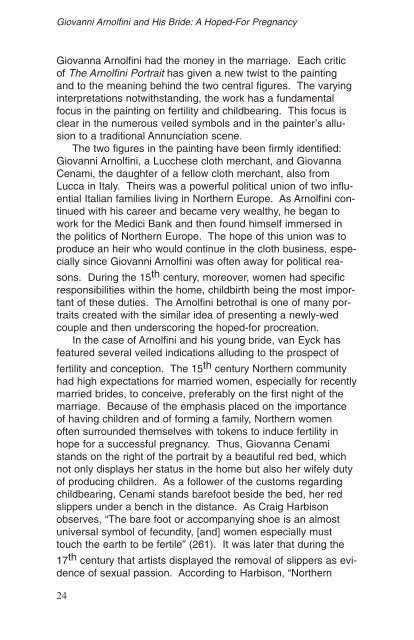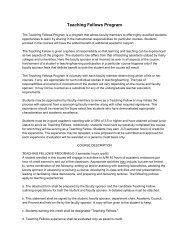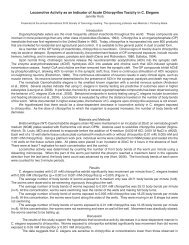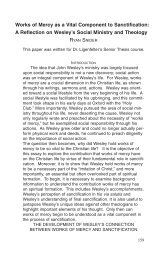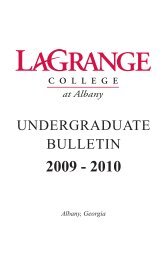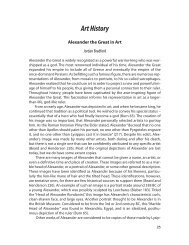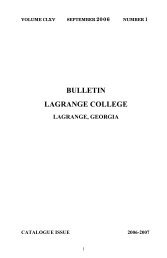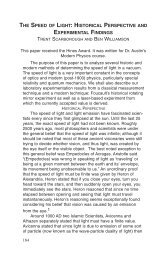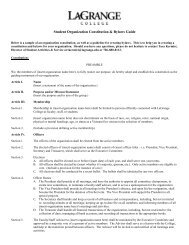Giovanni Arnolfini and His Bride
Giovanni Arnolfini and His Bride
Giovanni Arnolfini and His Bride
You also want an ePaper? Increase the reach of your titles
YUMPU automatically turns print PDFs into web optimized ePapers that Google loves.
<strong>Giovanni</strong> <strong>Arnolfini</strong> <strong>and</strong> <strong>His</strong> <strong>Bride</strong>: A Hoped-For Pregnancy<br />
Giovanna <strong>Arnolfini</strong> had the money in the marriage. Each critic<br />
of The <strong>Arnolfini</strong> Portrait has given a new twist to the painting<br />
<strong>and</strong> to the meaning behind the two central figures. The varying<br />
interpretations notwithst<strong>and</strong>ing, the work has a fundamental<br />
focus in the painting on fertility <strong>and</strong> childbearing. This focus is<br />
clear in the numerous veiled symbols <strong>and</strong> in the painter’s allusion<br />
to a traditional Annunciation scene.<br />
The two figures in the painting have been firmly identified:<br />
<strong>Giovanni</strong> <strong>Arnolfini</strong>, a Lucchese cloth merchant, <strong>and</strong> Giovanna<br />
Cenami, the daughter of a fellow cloth merchant, also from<br />
Lucca in Italy. Theirs was a powerful political union of two influential<br />
Italian families living in Northern Europe. As <strong>Arnolfini</strong> continued<br />
with his career <strong>and</strong> became very wealthy, he began to<br />
work for the Medici Bank <strong>and</strong> then found himself immersed in<br />
the politics of Northern Europe. The hope of this union was to<br />
produce an heir who would continue in the cloth business, especially<br />
since <strong>Giovanni</strong> <strong>Arnolfini</strong> was often away for political reasons.<br />
During the 15 th century, moreover, women had specific<br />
responsibilities within the home, childbirth being the most important<br />
of these duties. The <strong>Arnolfini</strong> betrothal is one of many portraits<br />
created with the similar idea of presenting a newly-wed<br />
couple <strong>and</strong> then underscoring the hoped-for procreation.<br />
In the case of <strong>Arnolfini</strong> <strong>and</strong> his young bride, van Eyck has<br />
featured several veiled indications alluding to the prospect of<br />
fertility <strong>and</strong> conception. The 15 th century Northern community<br />
had high expectations for married women, especially for recently<br />
married brides, to conceive, preferably on the first night of the<br />
marriage. Because of the emphasis placed on the importance<br />
of having children <strong>and</strong> of forming a family, Northern women<br />
often surrounded themselves with tokens to induce fertility in<br />
hope for a successful pregnancy. Thus, Giovanna Cenami<br />
st<strong>and</strong>s on the right of the portrait by a beautiful red bed, which<br />
not only displays her status in the home but also her wifely duty<br />
of producing children. As a follower of the customs regarding<br />
childbearing, Cenami st<strong>and</strong>s barefoot beside the bed, her red<br />
slippers under a bench in the distance. As Craig Harbison<br />
observes, “The bare foot or accompanying shoe is an almost<br />
universal symbol of fecundity, [<strong>and</strong>] women especially must<br />
touch the earth to be fertile” (261). It was later that during the<br />
17 th century that artists displayed the removal of slippers as evidence<br />
of sexual passion. According to Harbison, “Northern<br />
24


